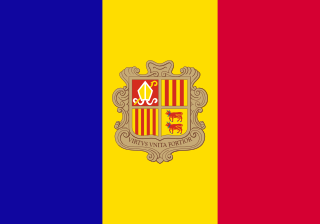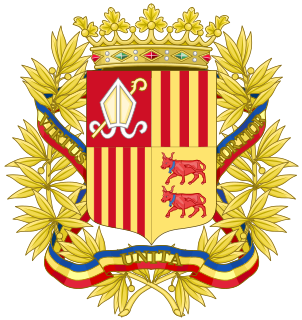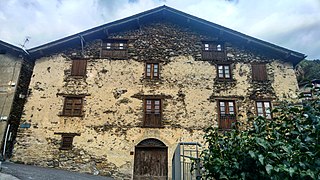This is a list of museums in Andorra .
This is a list of museums in Andorra .

Andorra, officially the Principality of Andorra, is a sovereign landlocked microstate on the Iberian Peninsula, in the eastern Pyrenees, bordered by France to the north and Spain to the south. Believed to have been created by Charlemagne, Andorra was ruled by the count of Urgell until 988, when it was transferred to the Roman Catholic Diocese of Urgell. The present principality was formed by a charter in 1278. It is headed by two co-princes: the Bishop of Urgell in Catalonia, Spain and the President of France. Its capital and largest city is Andorra la Vella.
Andorra, officially the Principality of Andorra, also called the Principality of the Valleys of Andorra, is a sovereign landlocked microstate in Southwestern Europe, located in the eastern Pyrenees mountains and bordered by Spain and France.

Andorra la Vella is the capital of the Principality of Andorra. It is located high in the east Pyrenees, between France and Spain. It is also the name of the parish that surrounds the capital.

Since the establishment of sovereignty with the ratification of the constitution in 1993, Andorra has moved to become an active member of the international community. In July 1993, Andorra established its first diplomatic mission in the world to the United Nations.

La Seu d'Urgell is a town located in the Catalan Pyrenees in Spain. La Seu d'Urgell is also the capital of the comarca Alt Urgell, head of the judicial district of la Seu d'Urgell and the seat of Bishop of Urgell, one of the Andorra co-princes. It is in the district of Alt Pirineu i Aran, and is the town with the most inhabitants, having 17.4% of the district population. La Seu d'Urgell and Puigcerdà together have 30% of the population of the area.

The co-princes of Andorra are jointly the heads of state of the Principality of Andorra, a landlocked microstate lying in the Pyrenees between France and Spain. Founded in 1278 by means of a treaty between the bishop of Urgell and the Count of Foix, this unique diarchical arrangement has persisted through medieval times to the 21st century. Currently, the bishop of Urgell and the president of France serve as Andorra's co-princes, following the transfer of the count of Foix's claims to the Crown of France and, thence, to the president of France. Each co-prince appoints a personal representative, the French co-prince currently being represented by Patrick Strzoda and the Episcopal co-prince by Josep Maria Mauri.
Crivillén is a municipality in the Andorra-Sierra de Arcos comarca, province of Teruel, part of the autonomous community of Aragon, Spain. According to the 2010 census the municipality has a population of 93 inhabitants. Its postal code is 44557.

Ordino is the most northerly parish in the Principality of Andorra. It's mostly the main area of Valira del Nord or Valira d'Ordino river valley. Ordino is also the name of the main town of the parish. Other settlements in the parish are El Serrat, Ansalonga, Sornàs, La Cortinada, Llorts, Segudet, Arans, Les Salines and Arcalís. It is home to the Sorteny National Park, the largest nature area of Andorra. It has a population of 4,858, as of 2017. The town preserves a vast medieval center, mainly linked to the culture of the country.

The Count of Foix ruled the independent County of Foix, in what is now southern France, during the Middle Ages. The House of Foix eventually extended its power across the Pyrenees mountain range, joining the House of Bearn and moving their court to Pau in Béarn. The Countess Catherine became queen of Navarre in 1483. The last count unified with King Henry IV of France in 1607.

The General Council is the unicameral parliament of Andorra. It is sometimes referred to as the General Council of the Valleys because it was the historical name and to distinguish it from similarly named bodies in the Val d'Aran and in France.

The Andorra National Library was founded in 1930, then re-opened in 1974. It is housed in Casa Bauró, an old manor house in the Andorran capital, Andorra la Vella. Amongst other functions, it is the legal deposit and copyright library for Andorra.

The following outline is provided as an overview of and topical guide to Andorra:

The Andorran government imposes no visa requirements on its visitors and only requires a passport or European Union national identity card for entrance. However, since the country is only accessible via the Schengen countries of Spain or France, entrance is not possible without entering the Schengen area first and the Schengen visa rules can therefore be regarded to apply de facto. Because Andorra is not part of the Schengen area, a multiple entry visa is required to re-enter the Schengen area when leaving Andorra. Foreign visitors looking to stay in Andorra more than 90 days require a residence permit.

Casa de la Vall is a historical house in Andorra la Vella, Andorra. It is the headquarters of the General Council of Andorra. It lies just to the southwest of the Andorra National Library. It is a heritage property registered in the Cultural Heritage of Andorra.

Legally, women in Andorra have equal rights under the laws of the Principality of Andorra. Politically, Andorran women won 15 out of 28 in seats in the country's legislature during the parliamentary election of 2011. For this reason, Andorra became the first nation in Europe and the second country internationally to have elected a "majority female legislature".
A museum is an institution that cares for (conserves) a collection of artifacts and other objects of artistic, cultural, historical, or scientific importance and makes them available for public viewing through exhibits that may be permanent or temporary. According to Museums of the World, there are about 55,000 museums in 202 countries. The International Council of Museums comprises 30,000 members in 137 countries.

The Casa Rull Museum is a historic house in La Massana, Andorra. It is named for the Rull family, landowning farmers, but grew to prominence when the Perich family of wealthy merchants married into the family in 1757. The house dates to 1732, but is on the site of earlier structures owned by the Rulls. It burnt down in the late 19th century, leaving only the stone walls, and was afterwards rebuilt. In 2000 the Andorran government opened the house as a museum.